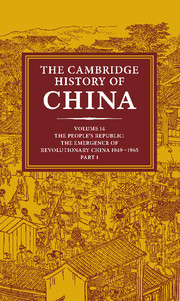Book contents
- Frontmatter
- 1 The reunification of China
- PART 1 EMULATING THE SOVIET MODEL, 1949–1957
- PART II THE SEARCH FOR A CHINESE ROAD, 1958–1965
- Bibliographical Essays
- Bibliographical essays for chapters
- Bibliography
- Appendixes: Meetings and Leaders
- Conversion Tables: pinyin and Wade-Giles
- Glossary Index
- Map 1. China’s physical features
- Map 2. PRC: political (Wade–Giles romanization)
- Map 3. PRC: political (pinyin romanization)
Bibliographical essays for chapters
Published online by Cambridge University Press: 28 March 2008
- Frontmatter
- 1 The reunification of China
- PART 1 EMULATING THE SOVIET MODEL, 1949–1957
- PART II THE SEARCH FOR A CHINESE ROAD, 1958–1965
- Bibliographical Essays
- Bibliographical essays for chapters
- Bibliography
- Appendixes: Meetings and Leaders
- Conversion Tables: pinyin and Wade-Giles
- Glossary Index
- Map 1. China’s physical features
- Map 2. PRC: political (Wade–Giles romanization)
- Map 3. PRC: political (pinyin romanization)
Summary
In his immediately preceding analytic survey of comprehensive proportions, Michel Oksenberg sets forth the essential sources for research on the People's Republic of China (PRC) and major books resulting from it. Inevitably, the following essays, geared to the chapters in this volume, repeat many of the references in that overview.
We believe this repetition may be helpful because the contributors present their own selections of the works important to their subjects, whereas Professor Oksenberg focuses mainly on China's political problems.
THE REUNIFICATION OF CHINA
One approach to this protean subject can begin with the comparison of dynasties, especially their founding and demise. There is less literature on this subject than one might expect. In 1944, sixteen Kyoto and Tokyo scholars joined in a project for a collaborative survey of the "dynasties of conquest," among which Japan at that time was trying to take its place. During the China Incident, a historical view of previous cases might be of use. In 1943 trie Tōa Kenkyūjo published a 300-page volume, Iminzoku no Shina tōchi gaisetsu (Outline of the rule of alien peoples over China). This surveyed the Northern Wei, Chin, Yuan, and Ch'ing as to origin, official and military systems, economic and religious institutions and policies toward China and Inner Asia. In 1952 was published a similarly path-breaking volume by Professor Ch'ien Mu of New Asia College in Hong Kong, entitled Chung-kuo li-tai cheng-chih te-shih.
Keywords
- Type
- Chapter
- Information
- The Cambridge History of China , pp. 591 - 608Publisher: Cambridge University PressPrint publication year: 1987



